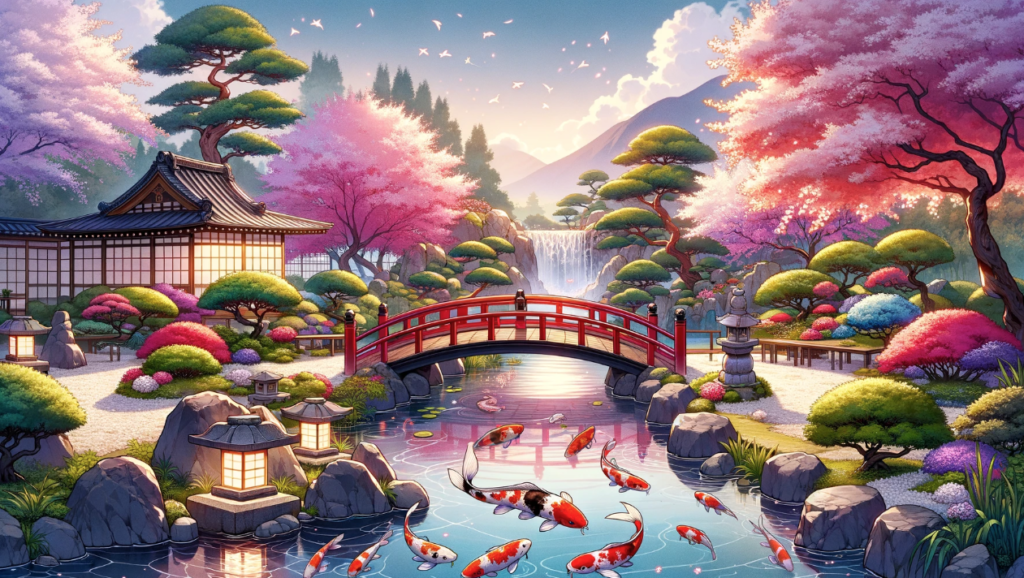
Lesson 32 Japanese Gardens
Topic Question: Can you explain the significance of Japanese gardens?
No. 1: Introduction – First, try answering the question yourself.
The instructor will provide advice on vocabulary, grammar, and expression corrections.
Sample Answer- Let’s read aloud. Instructor will check your pronunciation and accent.
Japanese gardens are much more than aesthetically pleasing landscapes; they are a form of art that reflects the philosophical and spiritual ideals of Japan. Rooted in Shinto, Buddhist, and Taoist philosophies, these gardens are designed to replicate natural landscapes in a more idealized form, promoting peace and tranquility. Elements such as rocks, water, bridges, and lanterns are not placed randomly but are carefully arranged to symbolize different aspects of nature and life, like permanence and the flow of time. The concept of “wabi-sabi,” appreciating the beauty in imperfection and transience, is also a significant aspect of Japanese gardens. They serve as a space for meditation and reflection, encouraging visitors to contemplate the deeper meanings of life and to find harmony with the natural world.
No. 2: Vocabulary Building – 5 Words to Learn and Their Meanings
Pronounce the Words Correctly (Pronunciation Training) + Make Sentences Using the Words Instantly
- Aesthetically (美学的に, bigakutekini): In a way that relates to the appreciation of beauty.
“Japanese gardens are designed aesthetically to evoke a sense of beauty and serenity.”
- Philosophical (哲学的, tetsugakuteki): Relating to or devoted to the study of the fundamental nature of knowledge, reality, and existence.
“The design of Japanese gardens is deeply philosophical, reflecting the principles of harmony and simplicity.”
- Tranquility (静けさ, shizukesa): The quality or state of being tranquil; calm.
“One of the main goals of Japanese gardens is to create an atmosphere of tranquility and peace.”
- Wabi-sabi (侘寂): A Japanese aesthetic concept that finds beauty in imperfection and impermanence.
“The concept of wabi-sabi is central to the design of Japanese gardens, emphasizing simplicity and the beauty of aging.”
- Harmony (調和, chōwa): The quality of forming a pleasing and consistent whole.
“Japanese gardens are designed to achieve harmony between man-made structures and the natural landscape.”
No. 3: Key Idiom and Example Sentences
“A picture is worth a thousand words” (一画千言): Suggests that a complex idea can be conveyed with just a single image, or that an image conveys its meaning more effectively than a description does.
“A stroll through a Japanese garden is like witnessing ‘a picture is worth a thousand words,’ where every element tells a story of nature and harmony.”
“In understanding the significance of Japanese gardens, ‘a picture is worth a thousand words,’ as the visual experience conveys much more than words can express about their beauty and depth.”
No. 4: Discussion and Exchange of Opinions on the Sample Answer
Instructor: Based on the sample answer, in what ways do you think Japanese gardens reflect the cultural and spiritual values of Japan?
Student: [Opinions of students]
No. 5: Free Discussion on the Topic
Let’s explore further the cultural significance and various styles of Japanese gardens. How do different types of Japanese gardens (such as Zen gardens, stroll gardens, tea gardens) serve different purposes and reflect different aspects of Japanese culture? Additionally, consider how the principles behind Japanese gardens can be applied to modern landscaping and urban design. How do these gardens influence contemporary architecture and outdoor spaces? Finally, discuss the global appeal of Japanese gardens and how they have been adapted or recreated outside Japan. What aspects of Japanese gardens do you think resonate most with people around the world?







